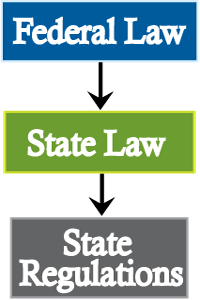Safe Drinking Water Act (Federal Law)
- A federal law which ensures safe drinking water for Americans
- Under this law the Environmental Protection Agency (EPA) sets standards for water quality of drinking water and oversees the states, localities, and water suppliers who implement those standards.
- EPA sets standards for approximately 90 contaminants in drinking water
State Safe Drinking Water Act (State Law)
- South Carolina state law that ensures safe drinking water for the citizens of South Carolina.
State Primary Drinking Water Regulations
- South Carolina State Regulations that implement and enforce the State Safe Drinking Water Act.
 National Primary Drinking Water Regulations
National Primary Drinking Water Regulations
- EPA requires public water systems to meet these standards.
- For a list of contaminants and their maximum contaminant levels (MCL), visit EPA's Drinking Water Contaminants Web site.
- Maximum Contaminant Level (MCL) is the highest level of a contaminant that is allowed in drinking water.
National Secondary Drinking Water Regulations (NSDWRs)
- NSDWRs are guidelines for 15 contaminants that may cause cosmetic or aesthetic effects in drinking water (i.e. skin or tooth discoloration, taste, odor, etc.), but pose no known health risk.
- The Environmental Protection Agency (EPA) recommends these secondary standards to public water systems, but does not require water systems to comply.
- States may choose to adopt secondary standards as enforceable standards.
- For more information, visit EPA's Secondary Drinking Water Regulations Web Site
Contacts
- Richard Welch, Jr. P.E., Manager, Drinking Water & Recreational Waters Compliance, (803) 898-3546
- Wendi Smith, Program Manager, Drinking Water Compliance Monitoring Section, (803) 898-2382